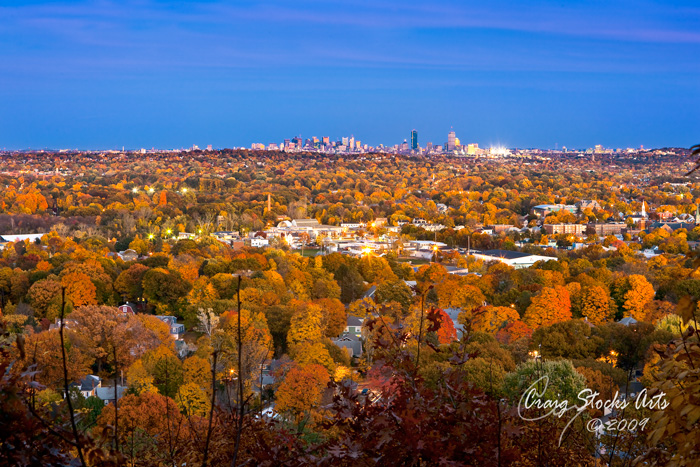Craig Stocks Arts Fine Art Photography and Artwork Duplication Services in Peoria and Central Illinois
October 27, 2009
Enhancing a Twilight Photo of Boston in the Fall
This example was done entirely in LIghtroom rather than Photoshop. Lightroom's full name is "Adobe Photoshop LIghtroom" which indicates that it is intended as a companion product. Of course, Adobe wants us to buy both Lightroom and Photoshop, but the two programs have different strengths. Photoshop is good for heavy-duty retouching, such as replacing skys in a landscape, swapping heads in a group portrait, or doing extensive portrait retouching. Lightroom is great at managing images from an entire shoot, such as a wedding, but it has only the basic processing tools. In terms of function, it's a combination of Bridge and Adobe Camera Raw (if you use Photoshop, you'll know what that means).
The photo below was taken from a park overlook in Waltham, looking east toward Cambridge and Boston. The sun was just setting behind us, and the building and street lights wre all coming on. The fall colors were in full bloom, and nearly every tree in sight was a bright yellow or red. Their color is accented by the red glow from the setting sun. I love the color contrast between the orange foilage and the blue sky.
Roll you mouse pointer over the image to see the original version. Since the lighting was very low and flat, the scene didn't have much contrast. In fact, there aren't any whites or blacks in the scene, just mid-tones. The colors are also pretty flat, again because of the low light level.
Fortunately, Lightroom is good at those kind of adjustments. The first step is to increase the Exposure setting, which mostly brightens the bright parts of the scene. Then, increase the Black setting, which pulls the dark tones back toward black. That gives the scene some overall contrast, and pop, but I also increased the contrast some more using the Contrast slider and the Tone Curve. Then, I increased both Vibrance and Saturation to make the colors pop.
The last major adjustment was to add a gradient to the sky. The gradient darkened the sky, increased the contrast and saturation, and added some blue.
I think the end result is a much better representation of what my eyes and mind saw. Our minds do a lot of visual interpretation that we're not even aware of, but cameras are simple machines. They record the photons as they actually appear. It's up to the artist to determine how they want to represent the scene.
